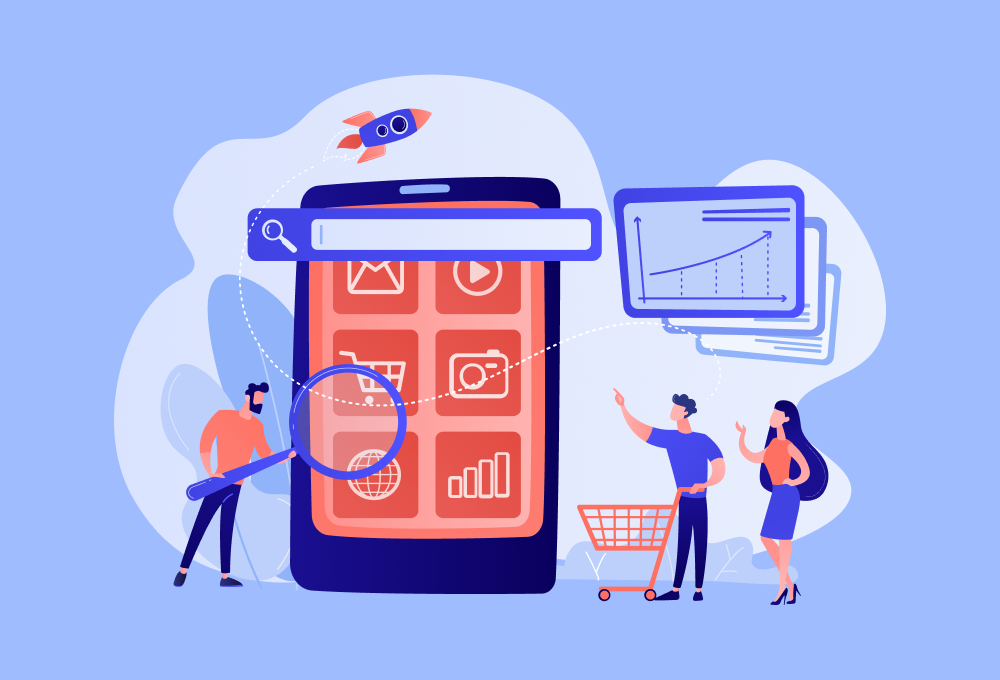Reading time: 10 min
Why Do You Need to Go eCommerce?
eCommerce has been an integral part of the business landscape for over three decades now. Internet sales have become pivotal in retail, constituting nearly 19% of global retail sales in 2021, projected to rise by 20.8% in 2023 and nearly a quarter by 2026.
In the era where digital transactions dominate, neglecting the transition to online sales could mean missing out on new avenues to attract customers. The modern consumer base, particularly the younger demographic, is more comfortable with online shopping. Moreover, people are more often keen on shopping on the go: mobile commerce is on the rise worldwide (3x higher retention rate compared to mobile sites); especially in Asia, which is currently at the forefront of technological progress in the field of Internet technologies. In Asia, some countries had almost 45 % of their population making weekly mobile purchases by the end of 2021.
In this case, failing to establish an online presence could lead to losing a substantial portion of your audience. The convenience, accessibility, and ease of comparison when shopping online are compelling reasons for customers to prefer virtual storefronts.
In the era where digital transactions dominate, neglecting the transition to online sales could mean missing out on new avenues to attract customers. The modern consumer base, particularly the younger demographic, is more comfortable with online shopping. Moreover, people are more often keen on shopping on the go: mobile commerce is on the rise worldwide (3x higher retention rate compared to mobile sites); especially in Asia, which is currently at the forefront of technological progress in the field of Internet technologies. In Asia, some countries had almost 45 % of their population making weekly mobile purchases by the end of 2021.
In this case, failing to establish an online presence could lead to losing a substantial portion of your audience. The convenience, accessibility, and ease of comparison when shopping online are compelling reasons for customers to prefer virtual storefronts.
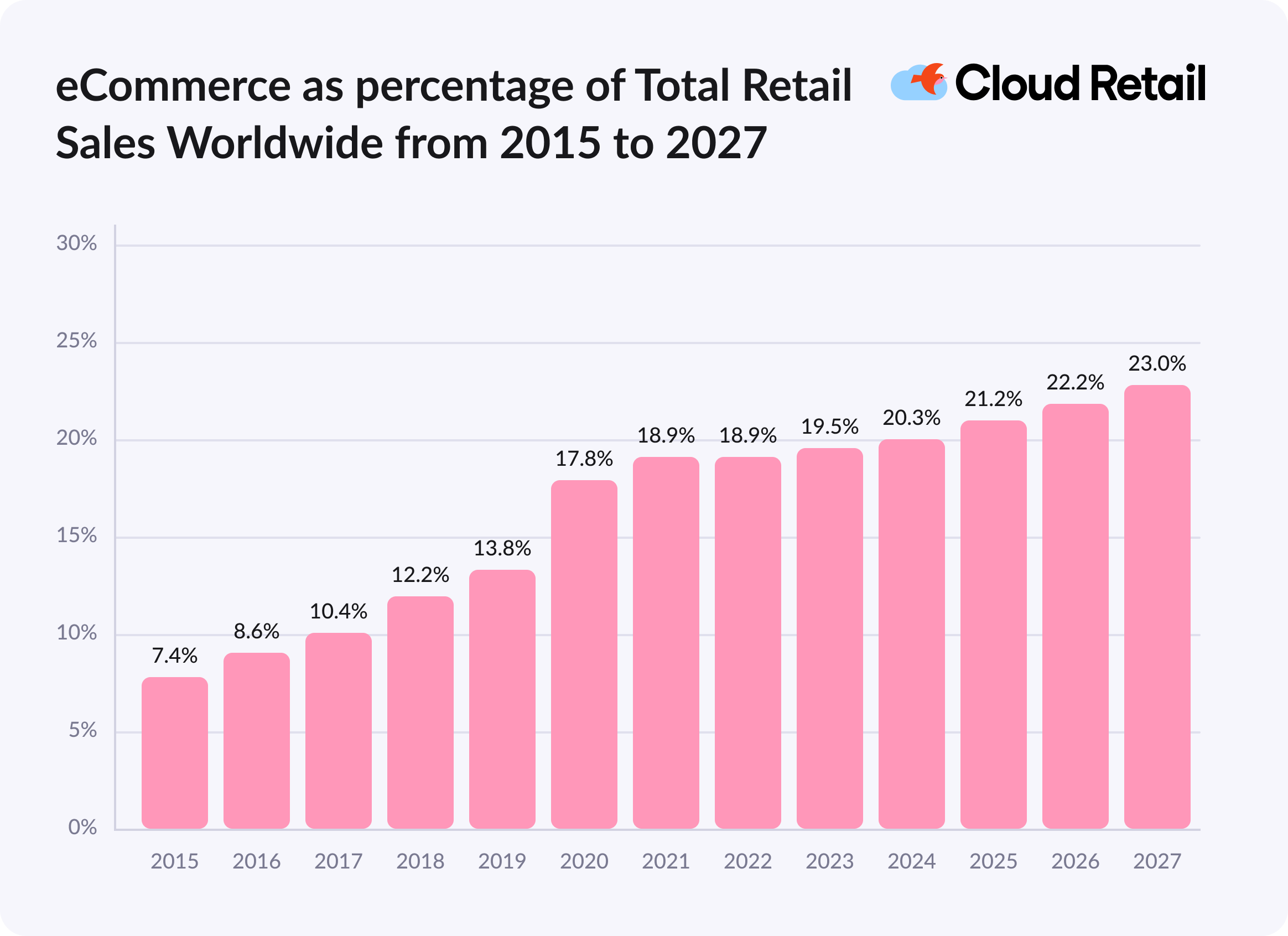
What if I Have an Offline Business and Want to Start Selling Online?
If you're considering moving your offline business into the digital realm, you're already heading in the right direction.
First, recognise your business' strengths, determine what value you can offer in the online segment, and then choose the appropriate online strategy. Next, assess your business model and operations, identifying the necessary adaptations for a successful online endeavour. Later in this article, these points will be discussed in more detail.
First, recognise your business' strengths, determine what value you can offer in the online segment, and then choose the appropriate online strategy. Next, assess your business model and operations, identifying the necessary adaptations for a successful online endeavour. Later in this article, these points will be discussed in more detail.
Many businesses hesitate to take the plunge into eCommerce due to several misconceptions:
Insufficient Awareness of the Benefits of eCommerce: Some businesses realise that establishing a new sales branch can be overwhelming and resource-heavy. As a result, the advantages of transitioning to eCommerce might appear unclear and not well-defined to them.
Operational Tunnel Vision: If you focus solely on existing operational processes, you won't be able to envision the future of your business online.
Technological Hurdles: Proficient in offline business operations, many companies face a deficiency in IT expertise. Creating a simple online shop is challenging by itself, so integrating logistics, procurement, and sales automation further complicates things.
Misconception About Costs: The belief that venturing into eCommerce is an expensive endeavour is a common barrier. However, it's crucial to grasp the financial distinction between staying offline, potentially losing some customers, or transitioning online and investing in the shift.
Moreover, while deliberating on the move, the risk of inertia looms large. Small businesses that quickly adapt to changes and implement modern approaches can easily outpace their larger, slower-moving counterparts.
Here is an example of that:
Instacart is an American delivery company that going exclusively online occupied the third place in the US’s online grocery market being purely online. Other mastodons like Kroger, Costco, and Albertsons lost their shares being slow in this online race.
Another example:
Once a retail leader in offline sales, Walmart swiftly adapted to changes and entered the online market in 2000. This proactive approach has enabled the company to maintain its top position in the country's online grocery sector to this day.
Operational Tunnel Vision: If you focus solely on existing operational processes, you won't be able to envision the future of your business online.
Technological Hurdles: Proficient in offline business operations, many companies face a deficiency in IT expertise. Creating a simple online shop is challenging by itself, so integrating logistics, procurement, and sales automation further complicates things.
Misconception About Costs: The belief that venturing into eCommerce is an expensive endeavour is a common barrier. However, it's crucial to grasp the financial distinction between staying offline, potentially losing some customers, or transitioning online and investing in the shift.
Moreover, while deliberating on the move, the risk of inertia looms large. Small businesses that quickly adapt to changes and implement modern approaches can easily outpace their larger, slower-moving counterparts.
Here is an example of that:
Instacart is an American delivery company that going exclusively online occupied the third place in the US’s online grocery market being purely online. Other mastodons like Kroger, Costco, and Albertsons lost their shares being slow in this online race.
Another example:
Once a retail leader in offline sales, Walmart swiftly adapted to changes and entered the online market in 2000. This proactive approach has enabled the company to maintain its top position in the country's online grocery sector to this day.
What Do I Need to Start Selling Online?
To kickstart your online selling journey effectively, there are 4 crucial steps you should take. Mastering these steps will pave the way for online sales success.
1) Defining Your Strategy:
The foremost step is to formulate a clear strategy for your online transition. Evaluate aspects of your business that can be effectively moved online and set goals for this transition.

For example:
It is very important to determine the target audience you will focus on online. For instance, if you have an offline clothing store for all age groups, when you transition online, you will need to adapt to people of different ages and their varying levels of Internet literacy. Therefore, it might be better to create two online stores, one for adults and one for young audiences. This way, you will have a personalised approach to each audience segment, increasing the likelihood of succeeding in online retail.
2) Business Model:
There are lots of different eCommerce models out there. To determine how you will generate revenue online you need to understand which model suits you best.
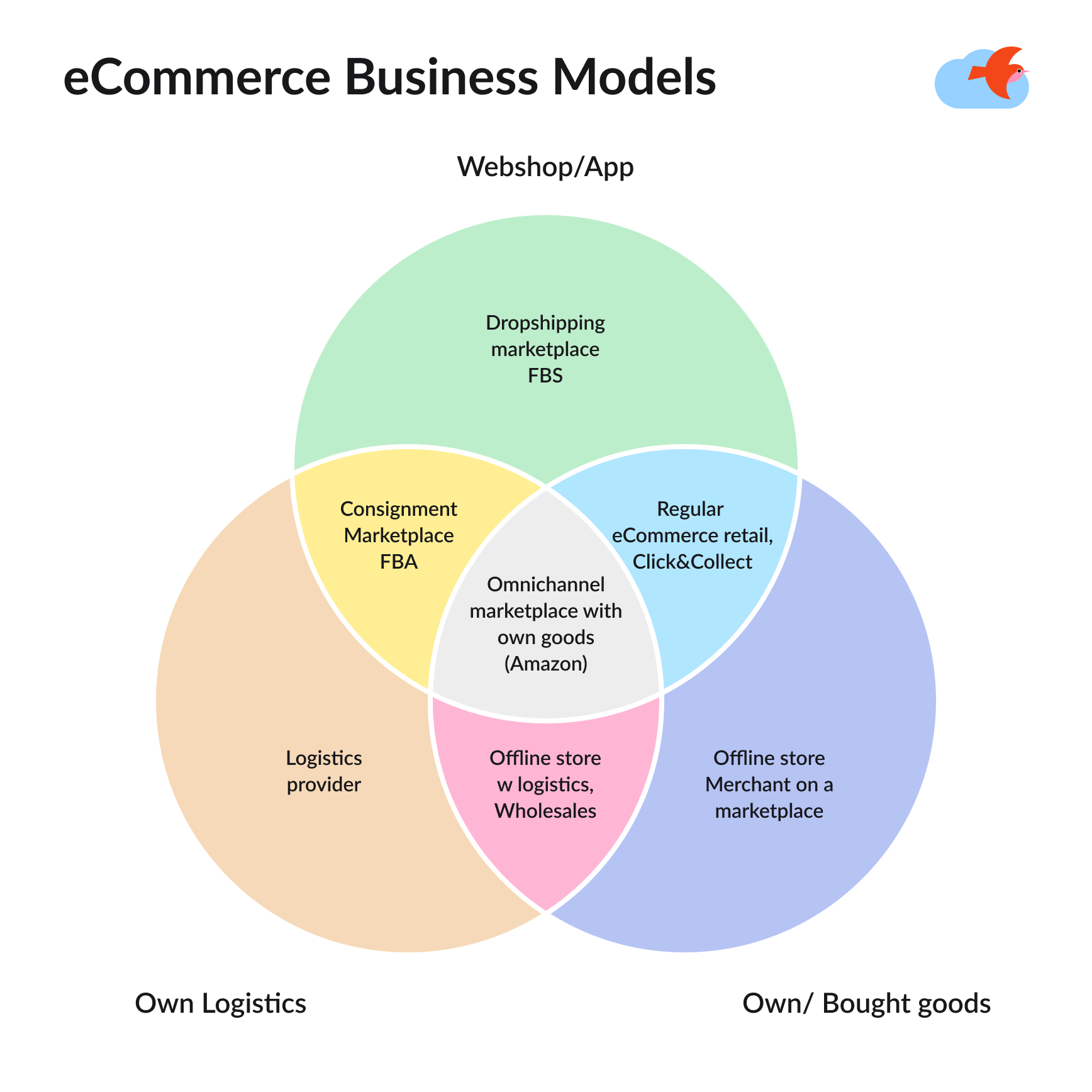
According to business principles:
Standard Retail. This is the operational scheme of a store/marketplace where products are stored/sold from the store/marketplace's controlled warehouse. Inventory and delivery are managed by the retailer, and the level of service is fully provided by the retailer to the user.
Dropshipping. This is a scheme where product sales occur directly from the merchant's warehouse, bypassing the retailer's main fulfilment operations.
There are also some combinations and derivatives of these models, such as Vendor Managed Inventory (VMI), which involves ordering products as needed. The product is located in the vendor/merchant's warehouse at the time of ordering, and the retailer handles the entire order fulfilment process.
Dropshipping. This is a scheme where product sales occur directly from the merchant's warehouse, bypassing the retailer's main fulfilment operations.
There are also some combinations and derivatives of these models, such as Vendor Managed Inventory (VMI), which involves ordering products as needed. The product is located in the vendor/merchant's warehouse at the time of ordering, and the retailer handles the entire order fulfilment process.
According to contractual principles:
Agency Agreement. The work is based on a tariff, even if that tariff is a percentage. The main difference is that the agent only executes order fulfilment. You are responsible for finding the sales channels by yourself.
Agency Agreement (Responsibility over the goods is handed over to the seller). Actions performed based on a power of attorney. This type of trade agreement is rarely used as a retail business model, but transportation and logistics under this agreement are relatively common.
Commission Trade. It is a scheme when products are sold on your website on behalf of the product owner. This is the most common operational scheme for marketplaces.
Agency Agreement (Responsibility over the goods is handed over to the seller). Actions performed based on a power of attorney. This type of trade agreement is rarely used as a retail business model, but transportation and logistics under this agreement are relatively common.
Commission Trade. It is a scheme when products are sold on your website on behalf of the product owner. This is the most common operational scheme for marketplaces.
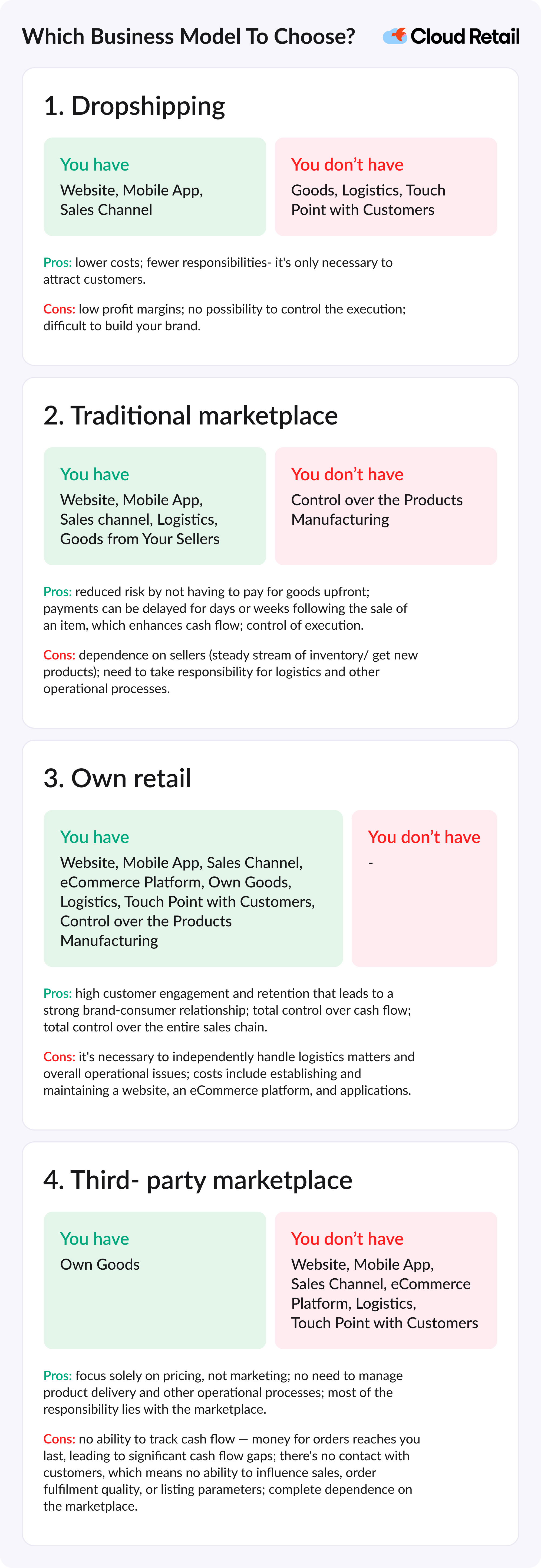
To make it even more clear:
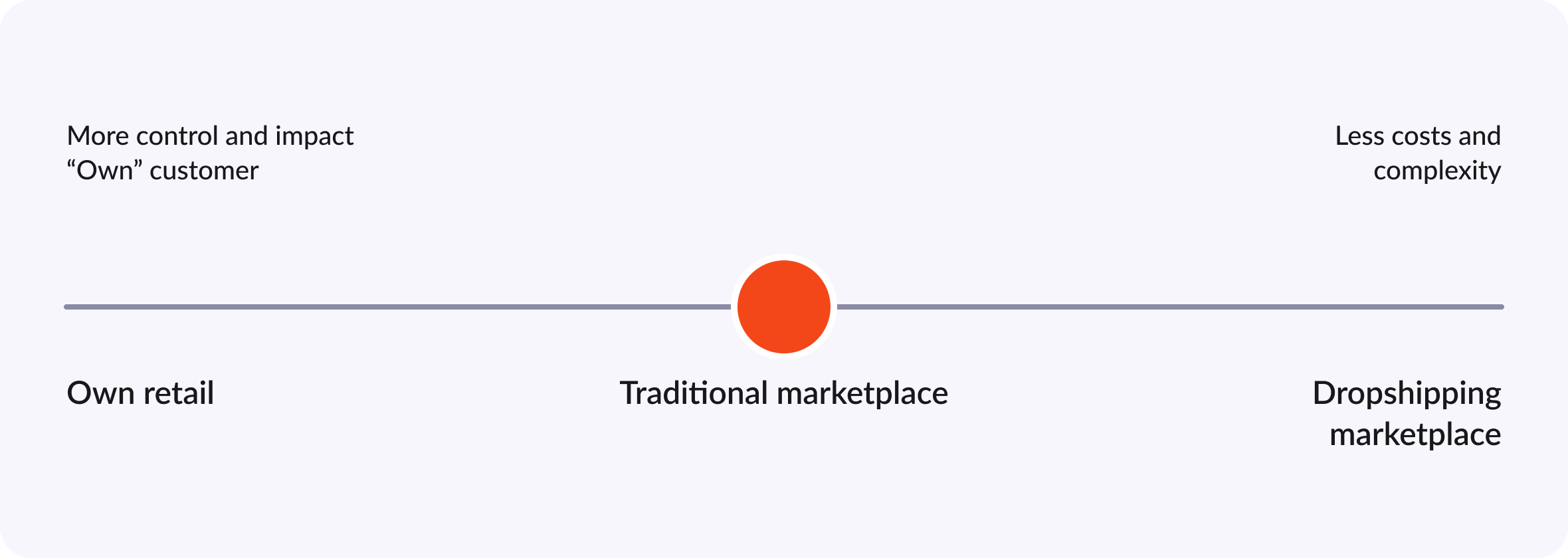
3) Select Tools + Operational Setup:
Choose the appropriate eCommerce platform for your needs. This can range from creating your online store to utilising existing eCommerce marketplaces. Establish operational processes and define specific KPIs for process performance assessment.
To facilitate a successful eCommerce journey, you'll also need the following tools:
To facilitate a successful eCommerce journey, you'll also need the following tools:
Sales Channels:
Identify the platforms and channels where you'll sell your products. For example, an eCommerce website, social media platforms, or mobile apps.
eCommerce Platform:
Utilise a platform that handles orders, payments, and transactions, such as an Order Management System (OMS) or billing registry. Additionally, ensure meticulous stock management to avoid any inventory-related hiccups.
Operational Tools:
Tailoring your approach to your operational model is key.
If you manage operations from your own warehouse, it's important to establish a robust warehousing system. Alternatively, if you operate from a physical store, consideration should be given to your store and picking system. Additionally, integrating a reliable POS system is essential for smooth transactions.
Delivery System / Integrations:
Integrate with a reliable delivery system to ensure timely and accurate order delivery.
Marketing CRM System:
Employ a CRM system to manage and analyse customer interactions and data throughout the customer lifecycle.
CRM systems compile customer data across different channels, or points of contact, between the customer and the company, which could include the company's website, telephone, live chat, direct mail, marketing materials, and social networks.
Business Intelligence (BI):
Through data visualisation, reporting tools, and data mining techniques, BI empowers organisations to uncover valuable insights, trends, and patterns within their data. This enables companies to make strategic choices that drive growth and efficiency.
Identify the platforms and channels where you'll sell your products. For example, an eCommerce website, social media platforms, or mobile apps.
eCommerce Platform:
Utilise a platform that handles orders, payments, and transactions, such as an Order Management System (OMS) or billing registry. Additionally, ensure meticulous stock management to avoid any inventory-related hiccups.
Operational Tools:
Tailoring your approach to your operational model is key.
If you manage operations from your own warehouse, it's important to establish a robust warehousing system. Alternatively, if you operate from a physical store, consideration should be given to your store and picking system. Additionally, integrating a reliable POS system is essential for smooth transactions.
Delivery System / Integrations:
Integrate with a reliable delivery system to ensure timely and accurate order delivery.
Marketing CRM System:
Employ a CRM system to manage and analyse customer interactions and data throughout the customer lifecycle.
CRM systems compile customer data across different channels, or points of contact, between the customer and the company, which could include the company's website, telephone, live chat, direct mail, marketing materials, and social networks.
Business Intelligence (BI):
Through data visualisation, reporting tools, and data mining techniques, BI empowers organisations to uncover valuable insights, trends, and patterns within their data. This enables companies to make strategic choices that drive growth and efficiency.
4) Devise Marketing and Sales Channels:
By strategically designing these channels you increase customer reach, improve brand visibility, and ultimately help your business grow.
How Fast Can I Do It and How Much Will It Cost Me?
The speed of implementing solutions depends on several factors.
The first is the complexity of the chosen solution. If it's a simple dropshipping website, it is faster to enter the online market. You can use a website builder and start working with minimal investments. If it is a full-fledged complex marketplace, making it work can take a lot of time and resources, including intellectual and financial ones.
The second is the implementation of the chosen solution. To launch your software or platform, it is not necessary to write your own code, which would be quite expensive and time-consuming. There are many existing solutions on the Internet that specialise in different areas of eCommerce, such as delivery software, payment software, marketing software, etc.
But with this variety of offers on the market, it is important to remember that the selected software should meet your current needs. It should also highlight your business's uniqueness. Therefore, you will probably need to customise some functionalities individually according to your request. In the long- term, this will be cheaper for small and medium businesses because specialised services are designed for this. But from a long-term perspective with the further goal of scaling, such solutions can be unreasonably expensive.
The third point stems from the second one. It is a choice between end-to-end solutions and custom software, which you write or buy and tailor to your needs. The second option is suitable for companies looking to develop IT skills. However, if this task is not a priority at a particular moment or you do not have much IT expertise, an end-to-end solution is more appropriate. This option is easily scalable and customizable in the business operation process.
Overall, your own IT costs about 10-15% of the total investment cost in transitioning to eCommerce.
So the speed of your transition to eCommerce depends on your chosen approach.
The second is the implementation of the chosen solution. To launch your software or platform, it is not necessary to write your own code, which would be quite expensive and time-consuming. There are many existing solutions on the Internet that specialise in different areas of eCommerce, such as delivery software, payment software, marketing software, etc.
But with this variety of offers on the market, it is important to remember that the selected software should meet your current needs. It should also highlight your business's uniqueness. Therefore, you will probably need to customise some functionalities individually according to your request. In the long- term, this will be cheaper for small and medium businesses because specialised services are designed for this. But from a long-term perspective with the further goal of scaling, such solutions can be unreasonably expensive.
The third point stems from the second one. It is a choice between end-to-end solutions and custom software, which you write or buy and tailor to your needs. The second option is suitable for companies looking to develop IT skills. However, if this task is not a priority at a particular moment or you do not have much IT expertise, an end-to-end solution is more appropriate. This option is easily scalable and customizable in the business operation process.
Overall, your own IT costs about 10-15% of the total investment cost in transitioning to eCommerce.
So the speed of your transition to eCommerce depends on your chosen approach.
Where Do you want to be?
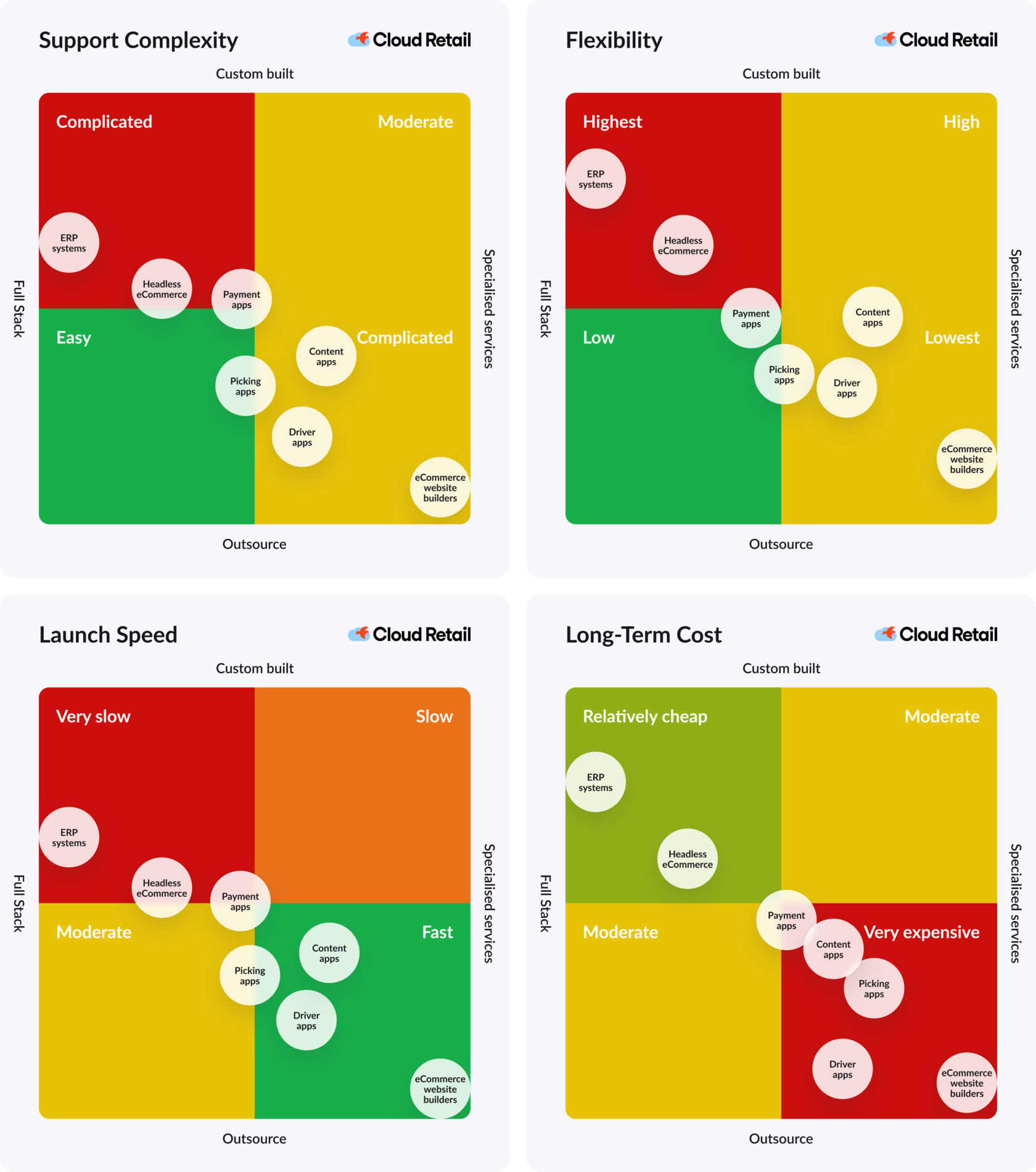
Full Stack Solution = the fastest way.
Collection of different tools from different providers = moderate.
Custom Development = the slowest way.
Conclusion.
We understand that this can be a complex and time-consuming process. Regardless of where you are in the eCommerce process, our experts are happy to help you achieve your goals. Please, contact us via web form.
